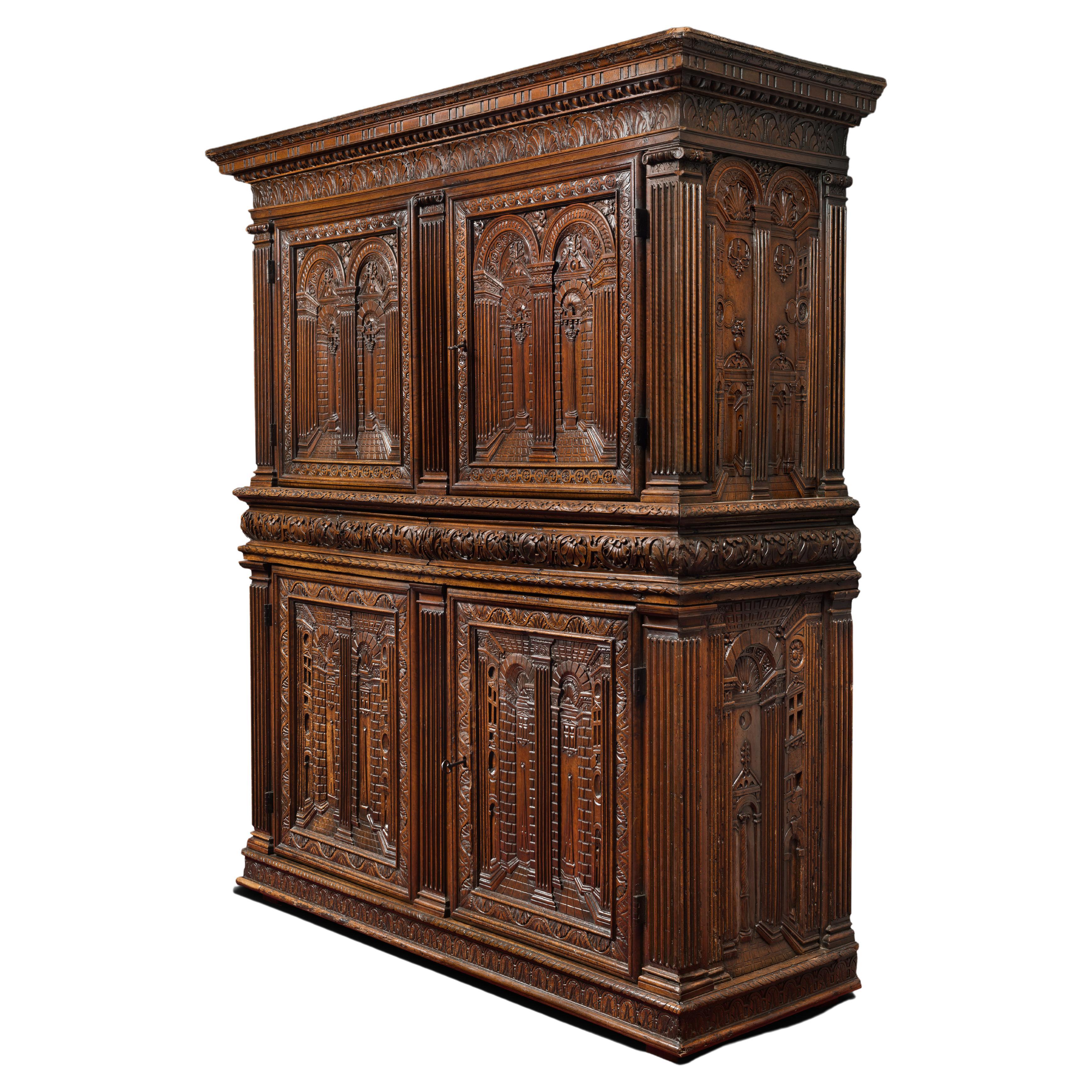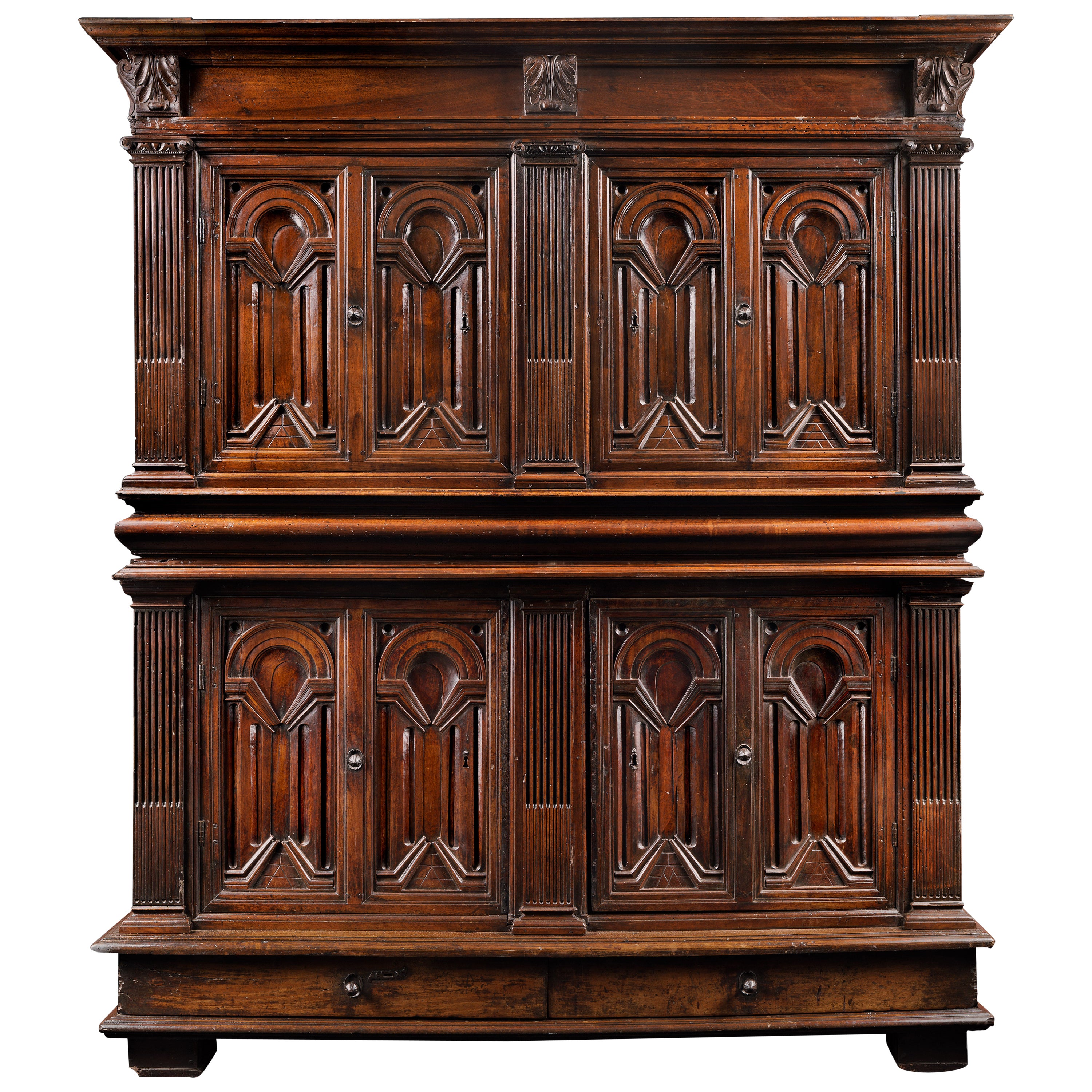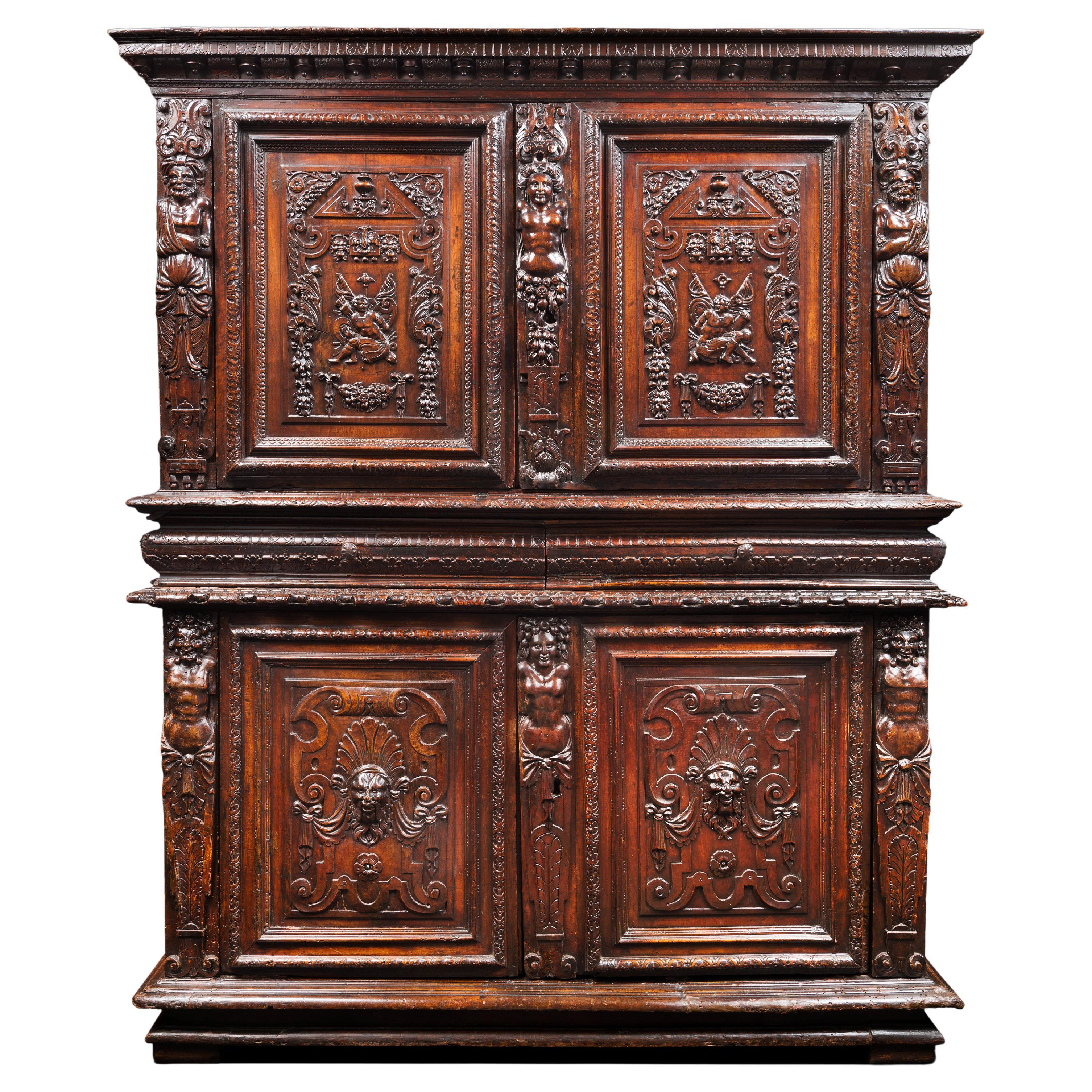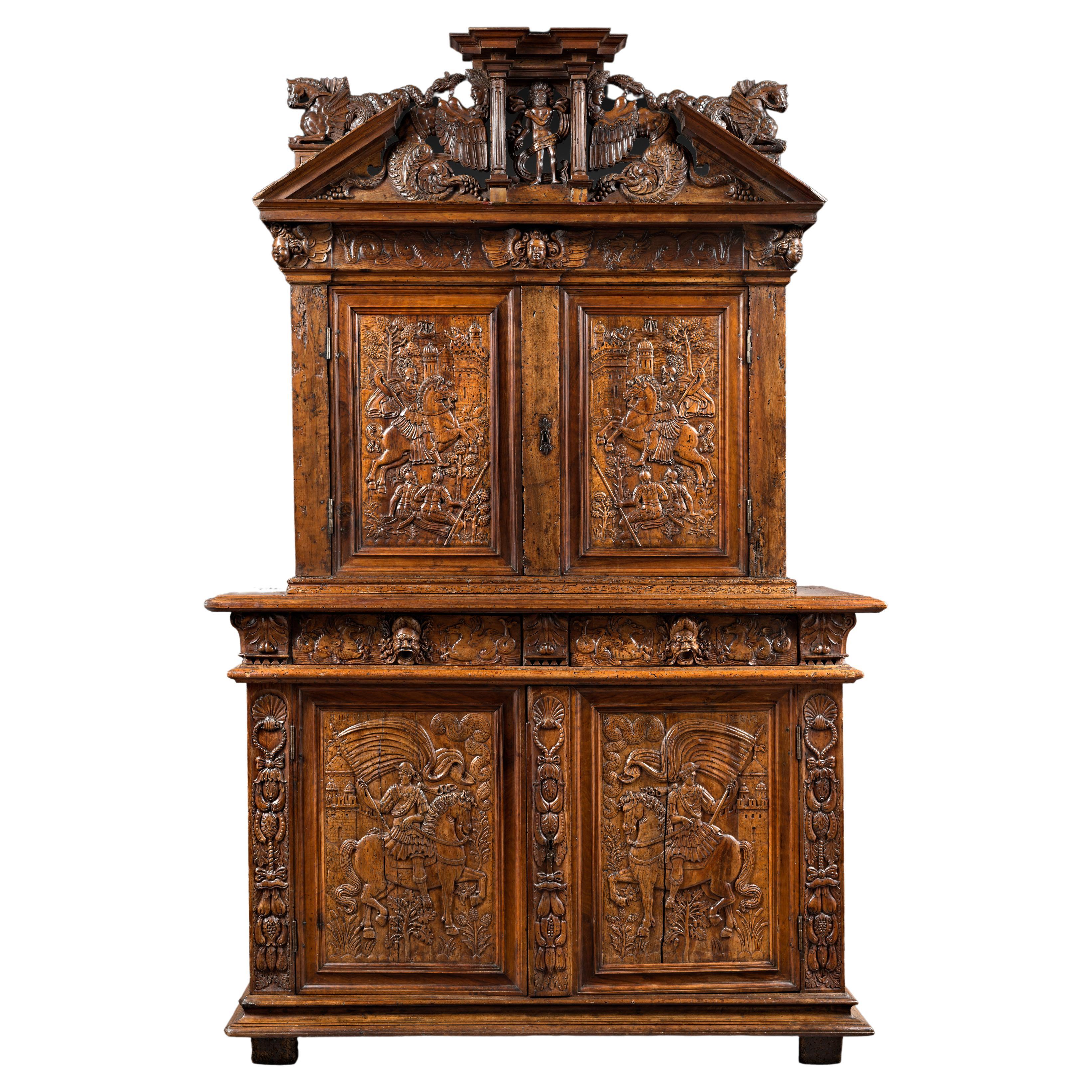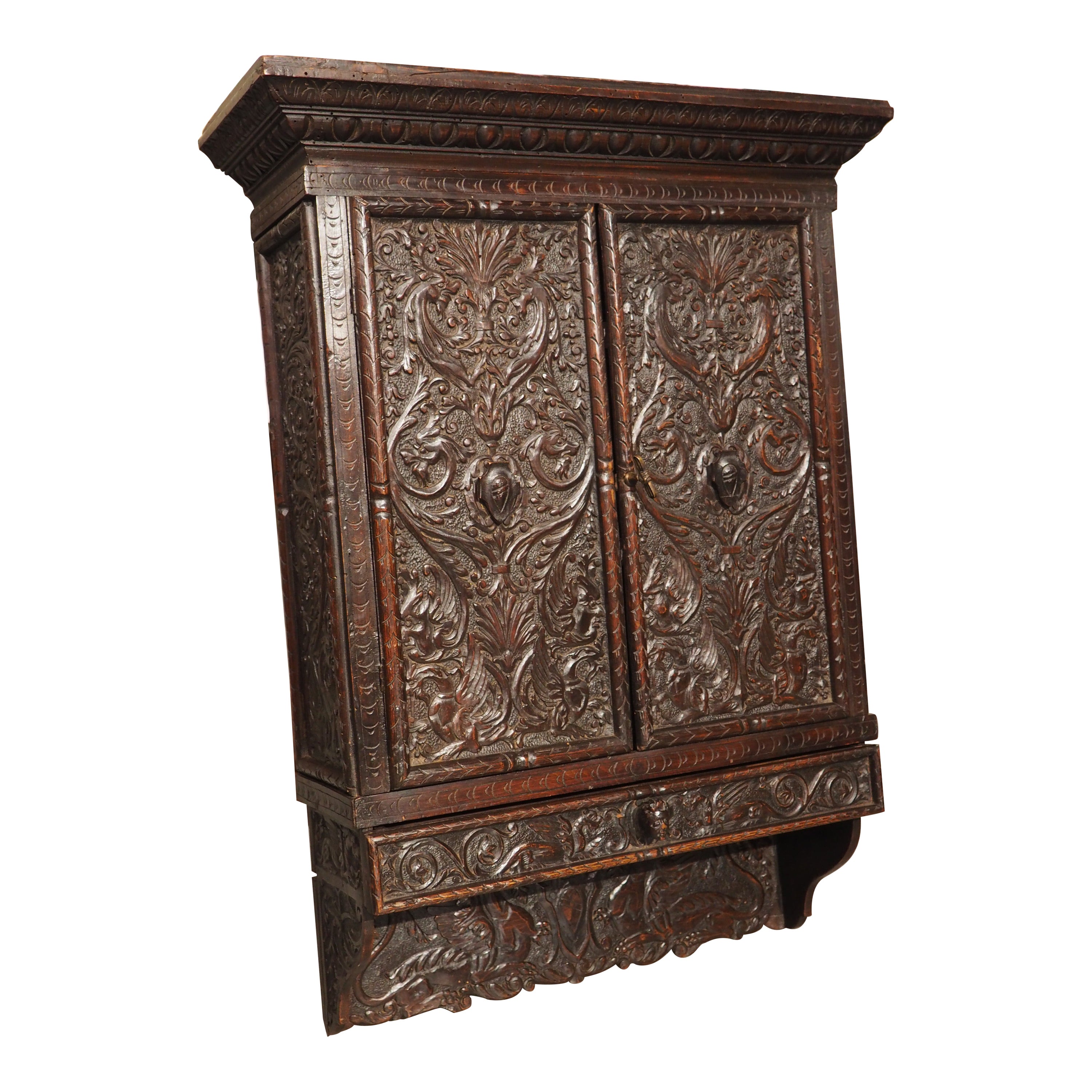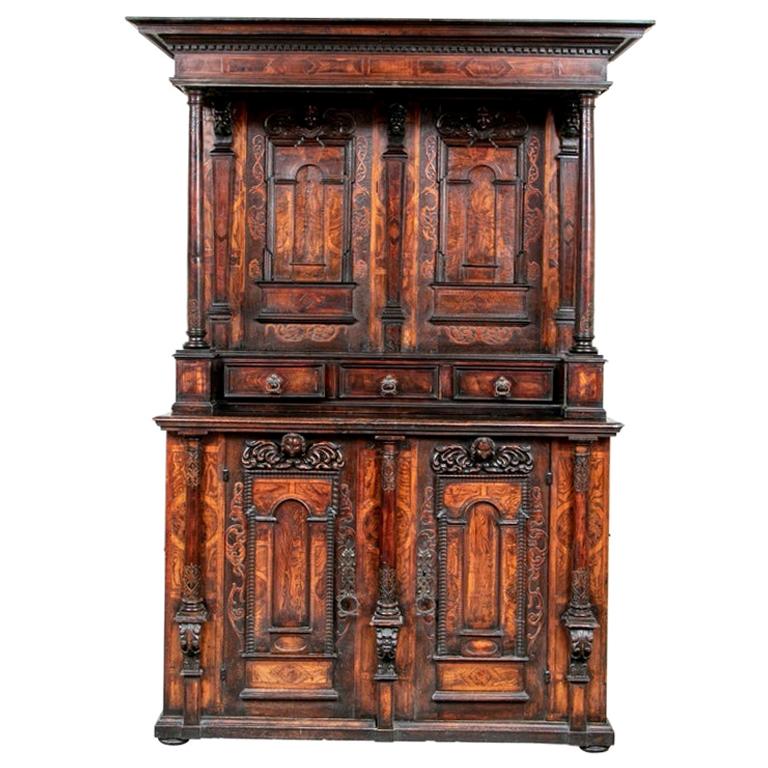Items Similar to French Renaissance Cabinet with Perspectives
Want more images or videos?
Request additional images or videos from the seller
1 of 7
French Renaissance Cabinet with Perspectives
About the Item
This Renaissance Cabinet reveals the great mastery of the Lyon workshops which are at the origin of its realization. Sculptors and wood-carvers worked here in symbiosis to express and translate ultramontane architectural perspectives.
Thanks to the enthusiasm of patrons for paintings of the First Italian Renaissance, rediscovering the mathematical principles and the antic architecture - many Italian artisans and engravers came to the French Court. The city of Lyon was at this period a real place of cultural and commercial convergence.
This cabinet with two recessed parts reveals four panels adorned with trompe l'oeil perspectives sculpted in low-relief, and a richly carved belt concealing two drawers. On a ternary rhythm, this cabinet presents a cornice with a suite of double consoles enriched by carved quill-feathers.
The upper body
The elongated upper body, brings elegance to this piece of furniture. The upper door-leaves present a mirrored architectural decoration composed in the foreground of two lateral pilasters with quill feathers. The windows in the upper part supports a large semicircular arch decorated with sculpted florets. Leaves of acanthus expand to the corners. The perspective gives an effect of depth thanks to a facade with two doric porticos, surmounted by four windows superimposed two by two.
The sobriety of the cabinet composition does not prevent ornamentation. In fact, the belt presents two drawers decorated with large carved acanthus leaves falling in a large gadrooned molding. On both sides, foliated consoles with a denticulated base express a typical aesthetic of the Renaissance.
The lower body
The door-leaves with the frontal perspectives varies from the upper body: a coffered double arched stands on a facade identical to the one of the upper body.
The feather quills and the consoles are typical motifs of the Lyon School of the Renaissance
A cabinet presenting perspectives in ‘trompe l'œil’ but with a more sober structure, is observable in the Mrs. Jacqueline Boccador writings.
The patina, the quality of execution and the originality of the decoration make this Cabinet with perspective a beautiful testimony of the Renaissance Lyonnaise.
Literature
J.BOCCADOR, Le Mobilier français à la Renaissance, Edition d’Art Monelle Hayot, 1988, p.188-192.
- Dimensions:Height: 76.78 in (195 cm)Width: 48.43 in (123 cm)Depth: 22.45 in (57 cm)
- Style:Renaissance (Of the Period)
- Materials and Techniques:
- Place of Origin:
- Period:
- Date of Manufacture:16th Century
- Condition:Repaired. Wear consistent with age and use. Minor losses. Minor structural damages. Minor fading.
- Seller Location:Saint-Ouen, FR
- Reference Number:1stDibs: LU3115327214352
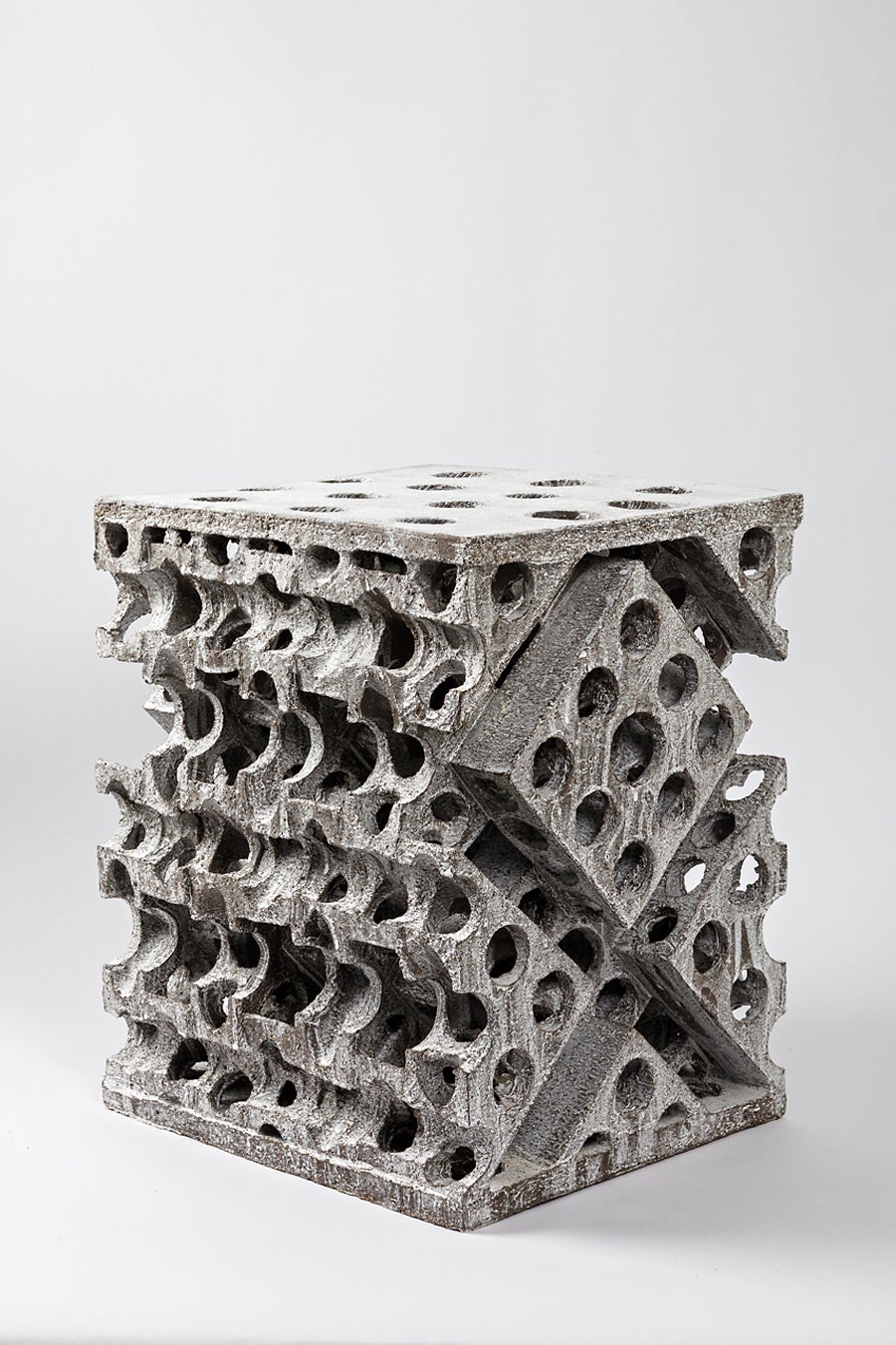
About the Seller
5.0
Vetted Seller
These experienced sellers undergo a comprehensive evaluation by our team of in-house experts.
Established in 2016
1stDibs seller since 2017
153 sales on 1stDibs
Typical response time: 7 hours
- ShippingRetrieving quote...Ships From: Saint-Ouen, France
- Return PolicyThis item cannot be returned.
More From This SellerView All
- Important Renaissance Cabinet from Lyon 'France' with a Decor of PerspectivesLocated in Saint-Ouen, FRAs soon as 1540 France's second Renaissance is in the making, intimately linked to the rediscovery of the Antique world. The development of the printing and engraving industry allows the spread of artworks and models in many cities and countries. The Italian influence can be perceived in every artistic field. While the French king entrust the most talented Italian artists with major projects such as Il Rosso or Primaticcio in Fontainebleau, French artists also travel to Italy to form themselves to this new style. In Italy they get acquainted with the work of Leo Battista Alberti the first to theorize perspective (De Pictura, 1435-36) and architecture (De re oedificatoria, 1541). Those two publications would have a revolutionary impact on arts. Furniture is marked by the work of the most famous Italian architects of the time as well as French architects. Indeed Philibert de l'Orme competes with Alberti and by the end of his life publishes several treaties including one devoted to a theory of architecture (1567). Unfortunately he would not live to complete the second volume. In this treaty he expresses his interest for mathematical norms applied to architecture, copied from the Antique. His journeys in Italy allowed him to accumulate the most sophisticated references. Jean Bullant, another architect of great talent also theorizes his practice. He establishes rules characterizing Greco-Roman art staying faithful to Vitruvius. Following this new inspiration the structure of furniture evolves. From then on appear columns, capitals, cornices, friezes and architraves. The ornamentation uses this inspiration as well with egg-and-dart, palm leaf and rose adorning the most beautiful pieces. In Lyon, crossroad where meet merchants from everywhere those new experiments are welcomed. Lyon florishing printing industry allows the spreading of models and treaties essential to the artist's work. Thus the first publication of Vitruvius' De Architectura in France would be printed in Lyon in 1532. Artists from Lyon rediscover and familiarize themselves with the Antique knowledge very early. They adopt those new ideas and use them in their own creations. Lyon cabinet-makers re interpret Antique architecture and Italian Renaissance palaces to give their pieces a pure and harmonious architectural structure. Grooved pilasters are particularly favored. They are topped by capitals of diverse orders always respecting the sequencing with simpler ones for the lower levels and the richest ones on the higher levels. As for the ornamentation, one of the great distinctiveness of Lyon workshops remains the architectural perspective illusions, drawing inspiration from Tuscany. True masterpiece of the Second French Renaissance this important cabinet illustrates Lyon workshops' taste for fine Italian architecture inspired by Antiquity. An architectural perspective of great quality is treated in symmetry on each panel. This two-bodied cabinet without recess stands on four rectangular feet. The base comprises a molding, a palm leaf frieze and is bordered by a braid. The lower body is divided by three grooved pilasters with Tuscan capitals framing two door-leaves. The two panels are encircled by a moudled frame with palm leaves. They are finely carved with a decor of fantasized architecture depicting an Italian Renaissance palace erected symmetrically on each side of a grooved pilaster. On the ground floor a door opens through a stilted arch while the stories are opened with mullioned windows, dormers and occuli. Two large pegged-boss cladded pillars support the entablature enriched by a palm leaf frieze upon which stands an arch whose coffered intrados is centred by a rose. Behind this arch a pyramid appears, standing in front of a second facade with a window topped by a broken curvilinear pediment under a cul-de-four with a shell. The checker flooring gives depth to the low-reliefs creating vanishing points structuring the panels and guiding the eye of the observer. A thin laurel braid highlights the belt of the cabinet where are located two drawers. Their facades are adorned by palm leaves in hoops. The upper body is encircled with palm leaves. The same ternary division as in the lower body appears. However, the pilasters are topped by Ionic capitals with volutes and egg-and-dart. The door-leaves are framed with flowers. On the panels the artist has designed another architectural decor. On the foreground open two arches on top of grooved pilasters with rectangular capitals adorned with palm leaves. The arches are enriched with braids and the coffered intrados bears a decor of roses. The spandrels also bear a flower decor. In the background another arcature hosts a fluted grooved column topped with double basket acanthus capital, characteristic of Corinthian order. The triangular pediment is interrupted by a choux bourguignon. A large cornice crowns the cabinet. It stands on pilasters and forms an entablature comprising a palm leaf frieze and an egg-and-dart, triglyph and palm leaf cornice. The cabinet's sides have also been carefully considered. The lower body's panels are enriched with an arch rising above a broken pediment portico hosting a twisted column. Flowers garnish the spandrels. An architectural facade completes the decor. The upper body's panels present two arches supported by a facade opened with dormers and mullioned windows as well as cartouches (one bears the inscription 1580 dating the cabinet) suggesting the interior of an Italian Renaissance palace, confirmed by the chandeliers. The flooring leads our gaze to a second arch with a broken curvilinear pediment where stands a flower vase. This arch opens onto a perspective of another facade along a road. Inside the cabinet, on the lower body door-leaves appear two designs. On the right door is depicted a Crucifixion. Saint Mary and Saint John flank the Christ on the cross. In the bottom part is inscribed « Dure uiator abis nihil haec spectacula curas / Pendenti cum sis unica cura Deo. / Tota suo moriente dolet natura Magistro. / Nil qui solus eras caussa dolenda doles. ». The signature [Christoff Swartz Monachiensis pinx[it] / Ioa[nnes] Sadeler sculp[it]] tells us it was made by Johan Sadeler I (1550-1600) after Christoph Schwartz (1548-1592). This engraving belongs to an ensemble depicting the Passion of Christ Johan Sadeler executed in 1589 after an altar piece painted by Christoph Schwartz for the private chapel of Renée of Loraine, wife of Duke William V of Bavaria. This altar piece made of nine copper panels has been destroyed during the 19th century. The Crucifixion panel once in the centre of the altar piece is the only one that survived and is today kept in Munich's Alte Pinakothek. On the left door appears Saint Francis receiving the stigmata. The inscription says : « Signastidomine Servum Tuum. Franciscum. Signis Redemptionis Nostrae ». This Renaissance cabinet with an architectural decor appearing as much in the structure faithful to Antique rules...Category
Antique 16th Century European Renaissance Cabinets
MaterialsWalnut
- Renaissance Palace Wardrobe with Perspectival ViewsLocated in Saint-Ouen, FRA rare carved walnut wardrobe opening with four door-leaves and two drawers in the lower part. The doors bear architectural views in low reliefs, fluted pilasters and Ionic capitals. Upper Body Two door-leaves with carved architectural perspectives open the wardrobe framed by three fluted pilasters with Ionic capitals. Each door-leaf depict two semi-circular arcades whose cornice and base shows a central vanishing point. Likewise the pavement’s lines act for the artisan as a way to create depth. The vaulting instead leads us to think the vanishing point has to be situated where the handle is, between the two complementaries reliefs. The elegant moulded belt hides an internal secret space, accessible through a moveable plank in the upper body. Lower Body Two door-leaves identical to those of the upper body framed by three fluted pilasters with Doric capitals. The base of the wardrobe opens with two large drawers. The sides also bear panels depicting architectural perspectives. The external pilasters share their Ionic capital with the facade’s pilasters. Thus we can observe on the wardrobe’s sides the capital’s lateral parts with the elegant volute specific to the Ionic order. This palace wardrobe is topped by an overlapping cornice standing on three consoles for the facade and two consoles on each sides. Placed right above the pilasters each console are adorned by fully expanded leaves. During the 15th century a major interest for architecture and perspective studies arises and influences patrons tastes. The work of great theorists such as Leon Battista Alberti...Category
Antique 16th Century Italian Renaissance Wardrobes and Armoires
MaterialsWalnut
- French Renaissance ArmoireLocated in Saint-Ouen, FROriginal lock and key This piece of furniture shows no recess on its upper part. It opens with four folding-doors and two drawers within the belt. The key bears the date 1524 above cross motifs. Burgundy and Lyon regions subordinated themselves to architecture in a different manner than the other french schools. Rather than using particularly columns and pediments pieces of furniture from Lyon borrow architecture’s organization principles and rigorous designs. On the upper body a strong feeling of balance and symmetry appears with the folding doors reliefs. Swags of flowers and fruits held with knot cloth centered by a man seating on his arms. Here profiles, masks and chou de Bourgogne mingle with the structuring scrolls. The two lateral terms wear draperies and the goddess Diana in the center wears a belt of fruits similar to Hugue Sambin’s designs (Termes de Diane et de Venus, 1554, BNF). The two palm-leaves enriched drawers and the alternating scrolls belt balance the weight of the cornice with its alternatings consoles and tops. The lower body is also adorned by three terms with a feminine one in the center, all three are wearing fruits on their heads. The folding doors are centered upon a motif of cut cuirs by a mask in high relief. Wearing a feathered tiara...Category
Antique 16th Century French Renaissance Wardrobes and Armoires
MaterialsWalnut
- 16th Century Cabinet with Knights Carving from Avignon Workshops 'France'Located in Saint-Ouen, FRCollection Jean Thuile Around the mid-sixteenth century French furnishing evolves in its conception and ornamentation. The start of major archi...Category
Antique 16th Century French Renaissance Cabinets
MaterialsWalnut
- Renaissance Cabinet form Lyon 'France'Located in Saint-Ouen, FRCondition : Partly dating from the Renaissance. The backs and the drawer’s insides have been re-done. Historical background The 16th century is a prosperous period for Lyon...Category
Antique 16th Century French Renaissance Cabinets
MaterialsWalnut
- 16th Century French Carved Renaissance CabinetLocated in Saint-Ouen, FRRare carved Renaissance cabinet Period : 2nd half 16th century, ca. 1570 Origin : France, Burgundy or Languedoc This cabinet embody the produ...Category
Antique 16th Century French Renaissance Cabinets
MaterialsWalnut
You May Also Like
- Circa 1830, Italian, Walnut Wood Wall Cabinet in the Renaissance StyleLocated in Dallas, TXHand-carved in Italy, circa 1830, this walnut wall cabinet has numerous Renaissance style motifs. The details are quite amazing, with all available space utilized. Even the edges of ...Category
Antique 1830s Italian Renaissance Cabinets
MaterialsWood, Walnut
- Notable circa 17th Century Carved Walnut Two-Tiered Cabinet in Renaissance StyleLocated in Bridgeport, CTA large and impressive 17th century European cabinet. Made in two parts, both with elaborate carved decoration and burled panels and details. The upper cabinet with heavy overhanging...Category
Antique 17th Century European Renaissance Cabinets
MaterialsWood
- 19th Century Dutch Hand Carved Renaissance Raised CabinetLocated in Dallas, TX19th century Dutch hand carved Renaissance raised cabinet was rendered from dense, old-growth quarter sawn oak, examples of which are on displa...Category
Antique Mid-19th Century Dutch Renaissance Revival Wardrobes and Armoires
MaterialsSteel
- 19th Century French Blue Painted Cabinet with 4 DoorsLocated in Atlanta, GALight blue painted cabinet / armoire with 4 cabinet doors and azure blue painted interior, 19th century France. Upper cabinets fitted with shelves...Category
Antique 19th Century French Cabinets
MaterialsWood
- Antique French Gothic Wardrobe, CabinetLocated in Dallas, TXAntique French Gothic wardrobe ~ cabinet is an intriguing example of the style, with no less than 23 hand-carved linenfold panels combining with ...Category
Early 20th Century French Gothic Revival Wardrobes and Armoires
MaterialsIron
- Cabinet with Multicolored WoodLocated in Saint-Ouen, FRCabinet with multicolored wood Measures: Height 64.18 in. (163 cm) Width 31.5 in. (80 cm) Depth 23.63 in. (60 cm) Black lacquered wood, aged mirror, silver leaf with a variety of translucid colors, wood veneer, anodized aluminium; Base: Acrilic and polished brass. Estimated production time: 14-15 weeks. Iconic and unparalleled, the Pixel Cabinet...Category
21st Century and Contemporary European Cabinets
MaterialsGold Leaf
Recently Viewed
View AllMore Ways To Browse
Renaissance Renaissance
Antique Renaissance
Furniture In The Renaissance
Antique Renaissance Furniture
French Two Part
Used Casement Window
Molding Cabinet
Large Renaissance
Renaissance French Renaissance
Renaissance France
French Renaissance
Recessed Cabinet
French Work Cabinet
French Two Piece Cabinet
Arched Cabinet
Arch Cabinet
Parts Cabinet
Recessed Storage Cabinets
